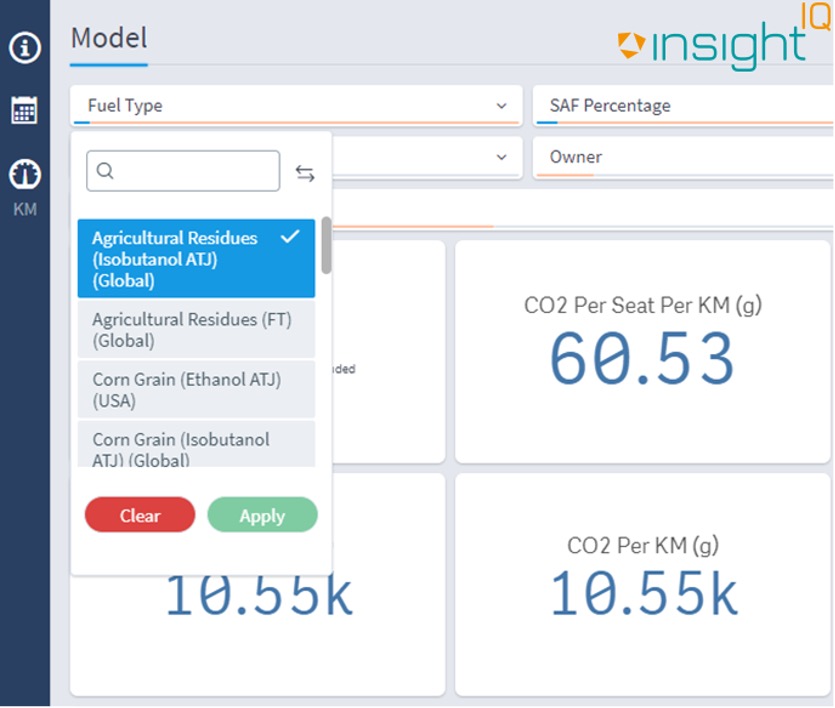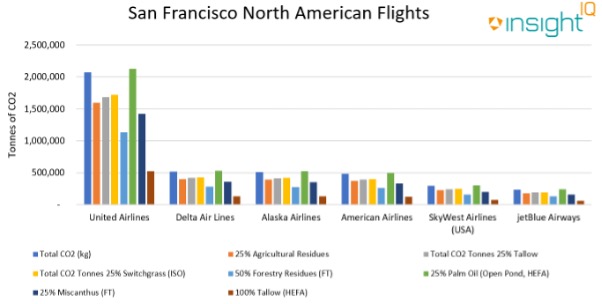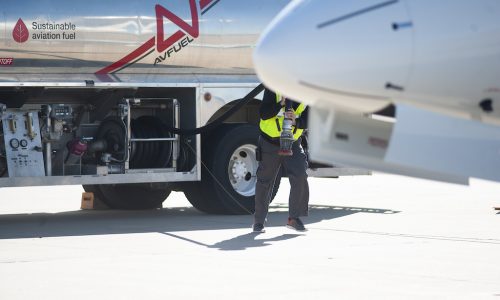Using unblended Sustainable Aviation Fuel (SAF) can reduce net CO2 lifecycle emissions by more than 75% when compared to conventional jet fuel, says aviation research house IBA.
However, when calculating any meaningful reductions in CO2, it is critical to understand the full Life Cycle Emissions Value (LSf), which includes the full impact of the production of the fuel, in addition to the combustion emissions from the aircraft’s engines.
That is the view of IBA, in its latest analysis drawing from its InsightIQ Carbon Emissions Calculator data platform
It states that the reduction of CO2 emissions is reliant on a variety of factors such as the feedstock used, how the feedstock was produced and what type of fuel conversion process is being used. These factors combined among many others are used to calculate a fuel’s Life Cycle Emissions Value.
IBA’s InsightIQ Carbon Emissions Calculator provides the ability to choose from 27 CORSIA Eligible Fuels, which are region specific and based upon geographical feedstock production. All have a Life Cycle Emissions Value to give greater clarity on the true CO2 reductions provided by SAF across specific flights, aircraft, fleet, airline or airport.

Source: IBA InsightIQ CEC
In recent months, IBA has seen “a significant uptake” in commitments to using SAF by operators.
Adds IBA: “Examples include Delta Airlines for 10 million gallons of SAF from producer Gevo. With further agreements between Neste, one of the largest SAF producers in the world, and Alaskan Airlines, JetBlue and American Airlines to operate flights from San Francisco International Airport (SFO) using a SAF blend.”
What is the potential impact on carbon emissions from SAF?
States IBA: “As an illustrative example, we can explore the top five emitting airlines in 2019 that departed from San Francisco International Airport (SFO) (and landed within North America). As demonstrated in the chart below, we can compare the impact on CO2 levels by switching to varying blends of SAF with Jet-A fuel across the year for the top six emitting operators.

Source: IBA InsightIQ CEC
“With the exception of using Palm Oil (Open Pond), there is a clear and distinct reduction in CO2 outputs – in the case of a 100% Tallow feedstock – we observe a 74.7% reduction in lifecycle emissions.”
IBA continues: “SAF produced from certain Palm Oil feedstocks in Indonesia can actually have a higher Lifecycle Emissions Value than that of Jet-A fuel due to significant deforestation and destruction of habitats, as well as increased risk of fires within the deforested areas.
“Jet-A, used as a datum point for carbon emission calculations, has an LSf of 89 gC02e/MJ whereas, Palm Oil which is produced using an open pond process, has an LSf of 99.1 gCO2e/MJ, 11.3% higher than Jet-A fuel.”
Whilst the industry will experience a shift towards a cleaner and carbon neutral future in the coming decades, IBA cautions: “There will be challenges in scaling up the technologies to meet the demands of this globalised industry.
“New technologies in propulsion and energy supply will have to be supported in parallel with high quality carbon offsetting schemes if the industry is to meet its targets.”
Potential users of IBA InsightIQ CEC can sign up for a demonstration by clicking here.

